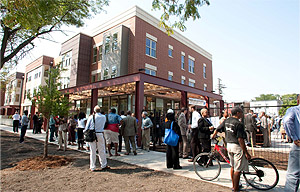Stabilizing communities and preserving housing in South Side Chicago
This summer Rance is working with Preservation of Affordable Housing, Inc, (POAH). POAH is a nonprofit organization whose mission is to preserve and steward affordable rental housing to provide stability, hope and economic security to low- and moderate-income individuals and families. POAH owns and operates close to 7,000 affordable homes at more than 50 properties in nine states and the District of Columbia. In particular, he will assist the Chicago office as a development intern, using his training in planning and development to help clear the various hurdles that arise during the development process for projects in demolition, construction, close-out phase and the initial acquisitions phase. Additional projects include developing a vehicle for acquiring and rehabilitating smaller two-family residential buildings and working on state or local public policy initiatives that support the office’s work in affordable housing and community revitalization.
From June to August, I am interning with Preservation of Affordable Housing (POAH) in there Chicago office. POAH is a national non-profit developer based in Boston that, in its 10 years of operations, has become a major player in affordable housing preservation, rehabilitation, property management and resident involvement.
 POAH came to Chicago in 2007 at the urging of the residents of Grove Park Plaza, a 504-unit Section 8 housing complex directly South of the University of Chicago in the neighborhood of Woodlawn. POAH first started managing the property through its affiliate Preservation Housing Management (as it standard practice to develop strong relationships with residents), bought the development, and the proceeded to plan and initiate a multi-phased redevelopment of the property, building existing affordable units on the original site, planning market-rate units on the site and simultaneously dispersing affordable housing units and spurring investment throughout the community.
POAH came to Chicago in 2007 at the urging of the residents of Grove Park Plaza, a 504-unit Section 8 housing complex directly South of the University of Chicago in the neighborhood of Woodlawn. POAH first started managing the property through its affiliate Preservation Housing Management (as it standard practice to develop strong relationships with residents), bought the development, and the proceeded to plan and initiate a multi-phased redevelopment of the property, building existing affordable units on the original site, planning market-rate units on the site and simultaneously dispersing affordable housing units and spurring investment throughout the community.
My responsibilities are pretty easily described as a project assistant for development. We are simultaneously completing a resource center for residents, demolishing the existing structure for the next phase of housing, designing a senior housing building, completing the rehabilitation of multi-family housing not on the site of the original Grove Park site and in talks to purchase additional properties that are part of larger neighborhood revitalization strategy. Development of affordable housing is not much different from traditional development, however it requires creative use of public subsidies and (when it is done right) varying degrees of resident services to improve the stability of the residents and their community.
In addition, I will be lending my hand towards the planned creation of a financial mechanism for acquiring and rehabilitation 2 to 6-unit buildings. These are not the type of buildings that POAH actively manages, but they are a significant portion of the housing stock, too often vacant and a barrier to improving the quality of the neighborhood.
The reason I sought out this opportunity at POAH is because of my attraction to the work of “preservation” that they champion. Housing policy is rife with debates about demand-side/people-focused versus supply-side/developer-focused approaches. In the middle of this debate is the simple fact that the share of existing affordable housing stock is declining as the result of conversions of affordable units to market-rate rentals or condos, replacement of 100% affordable housing developments with mixed income developments and other trends. Preservation takes this challenge head on.
Before POAH came to Woodlawn, the tenants’ association had unsuccessfully sought out a number of local affordable housing developers to take over the property that was slated to have its Section 8 contract with the Department of Housing and Urban Development terminated and converted to vouchers. This means the housing would have been demolished, residents would have been given a rent subsidy and left to look for housing across the City of Chicago. With the ever-present institutional expansion of nearby University of Chicago and transit-accessibility, the generally well-positioned community would surely have become gentrified, taken over by student housing, university buildings and related commercial development. Before long, existing residents would likely be forced out by improving real estate values. Instead, there will be income-restricted, well-managed and supportive communities that they can count on for 20+ years.
My goals for this summer is pretty simple. First, to continue learning about the process of developing affordable housing, as well as the broader approach to neighborhood revitalization. Second, to learn specifically about housing and community development Chicago and in particular the South Side. Lastly, to consider the role of a “planner” in the context of development. A planner can regulate from the office of city planning, but he or she can also development communities through the activities of real estate development. Development is a strenuous, detail-oriented process that is very much focused on market-imposed limitations (revenue generated, costs of management, securing capital in weaker market areas, etc.). Development is also about benefitting from an improvement in your community; comprehensive strategies, understanding community assets and introducing catalyzing investments is where the two activities collide.
This collision is a constant topic of internal deliberation for myself and I plan to use this blog to reflect and highlight a number of ideas, conflicts, community issues and experiences that I will encounter this summer.

